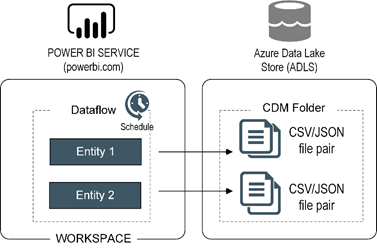Dataflows: The Good, the Bad, the Ugly
This blog is an update of my previous blog “Common Data Service for Analytics: The Good, the Bad, the Ugly“. Things have changed in the past 6 months. The Common Data Service for Analytics is no more. It got superseded by Power BI dataflows, which Microsoft officially introduced at the PASS Summit last week.
Think of dataflows as “Power Query in the Cloud”. Dataflows is to self-service BI what ETL is to Power BI pros.
A dataflow is a collection of Power Query queries, also known as entities, and it lives in a Power BI organizational workspace. For example, if I want to stage data from Salesforce, I can create a dataflow with as many entities as Salesforce tables I want to stage. Unlike Power Query, which can only output to a table in a data model, a dataflow saves its output as a pair of a CSV file (data) and JSON file (metadata) in Azure Data Lake Store (ADLS).
The Good
There is a lot to like about dataflows. I can think of two primary self-service scenarios that can benefit from dataflows:
- Data staging – Many organizations implement operational data stores (ODS) and staging databases before the data is processed and loaded in a data warehouse. As a business user, you can use data-flows for a similar purpose. For example, one of our clients is a large insurance company that uses Microsoft Dynamics 365 for customer relationship management. Various data analysts create data models from the same CRM data, but they find that refreshing the CRM data is time consuming. Instead, they can create a dataflow to stage some CRM entities before importing them in Power BI Desktop. Even better, you could import the staged CRM data into a single dataset or in an organizational semantic model to multiple data copies and duplicating business logic.
- Certified datasets – One way to improve data quality and promote better self-service BI is to prepare a set of certified common entities, such as Organization, Product, and Vendor. A data steward can be responsible for designing and managing these entities. Once in place, data analysts can import the certified entities in their data models.
There is a solid architecture, vision, and investments behind dataflows. You create dataflows using a tool that you’re already familiar with: Power Query. If you know Power Query, you know dataflows. Microsoft has provided the data lake storage and pricing is included in Power BI Pro/Power BI Premium. So, you have everything you need to get started with dataflows today. Ingesting the dataflow output is very fast too because you import CSV files.
The Bad
Let’s start with positioning. I’ve heard Microsoft position dataflows for any data integration task, from data staging to loading data warehouses and even replacing data warehouses and ETL (heard that vibe before?) I’ve seen business users doing impressive things with Power BI. But I’ve seen them also attempting to implement organizational solutions that collapse from their own weight. Dataflows are not an exception and I don’t think it’s a business user’s job to tackle ambitious data integration tasks.
You need Power BI Premium to realize the full potential of dataflows. For some obscure reason, features like linked and computed entities are not available in Power BI Pro. I wonder how many customers will feel pushed to go Power BI Premium as more and more features are only available there. I don’t mind scalability and performance related features but incremental refresh and linked entities?
The CSV output is both a blessing and a curse. True, ingestion is fast but text files are not a relational database. For example, the only option is to import the dataflow output in Power BI as DirectQuery is not available for text files.
The Ugly
You (almost) can’t access directly the output generated by dataflows. This precludes the continuum between self-service and organizational worlds. For example, IT might need to import a certified dataset into a data warehouse. But you can only connect to a dataflow in Power BI Desktop because the CSV files are not accessible. Power BI Premium will let you bring your own data lake storage in near future but a better option in my opinion was to provide access to the raw data in both Power BI Pro and Premium given that this is your data lake and your data.





